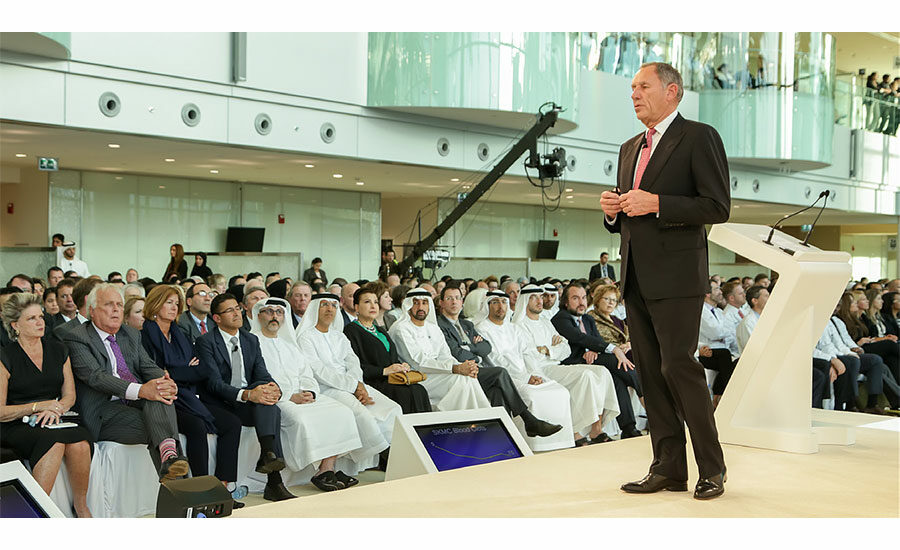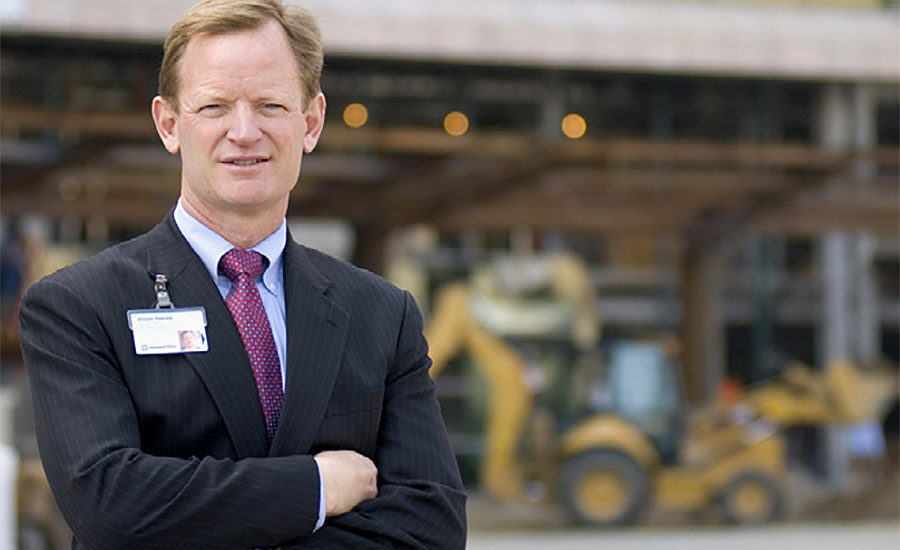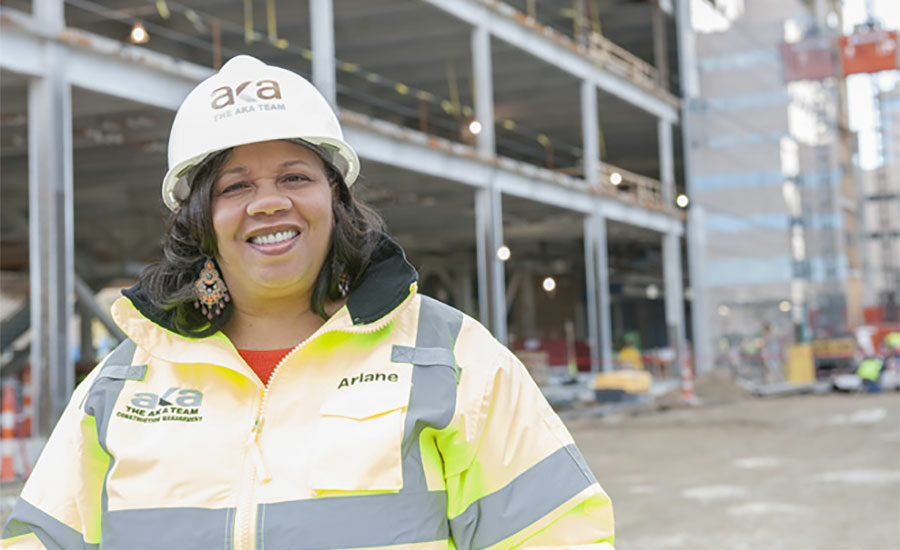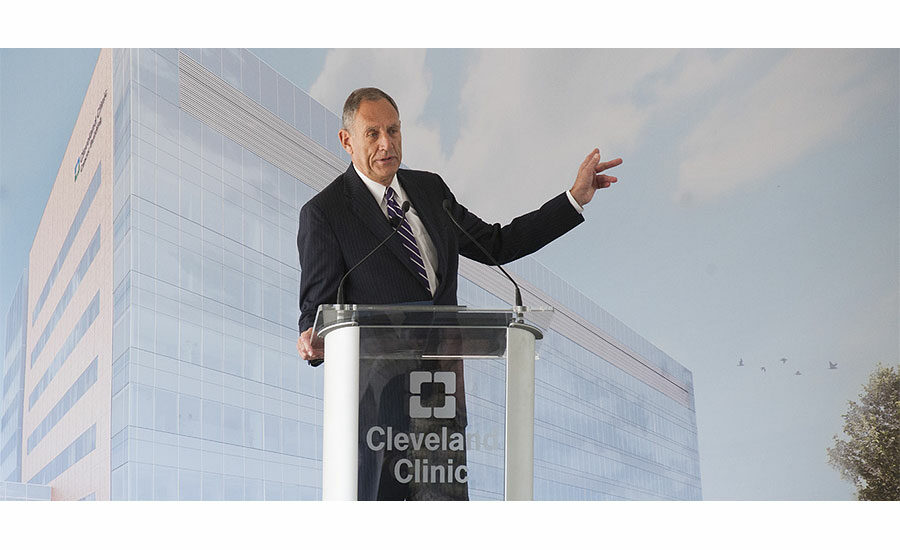Cleveland Clinic's Prescription for Growth
Health-care provider blends entrepreneurial zeal and cost-management into its global expansion

Hospital system also just broke ground for a state-of-the-art medical school with Case Western Reserve University.

GLOBAL FOOTPRINT Cosgrove addresses a gathering in the U.A.E., where CC has had long-standing relationships. It opened its first branded hospital in Abu Dhabi this year, a nearly $2-billion state-of-the-art facility.

Construction of the ambitious Abu Dhabi hospital, which opened later than anticipated, was managed by a UAE-based investment firm and includes LEED Gold features such as an innovative cooling system.

FORECASTER Health-care trends are followed to assess building impact, says CC’s Bill Peacock.

IMPACT CM Ariane Kirkpatrick sharpened her healthcare building skill in CC’s mentor-protégé program.

Cleveland Clinic CEO Toby Cosgrove aims to boost the hospital’s local presence with a $300-million cancer center now underway.








The prescription for success in health care is no different than for any other highly dynamic, competitive industry. But Cleveland Clinic has added something else to become a fast-growing, $6.5-billion non-profit health-care giant—an eye for entrepreneurship, pushed by President and CEO Delos M. “Toby” Cosgrove, M.D., in the decade since taking its helm.
Article Index:
The former cardiac surgeon—who had considered a career change as a venture capitalist and whose management chops made him, last year, a much-touted
candidate to lead the troubled U.S. Dept. of Veterans Affairs—has broadened the organization’s brand and presence beyond its downtown Cleveland main campus, reaching across Ohio, the U.S. and around the world.
The strategy requires facilities that are tailored to deliver a variety of specialized services. Cleveland Clinic’s (CC) current construction program includes a $300-
million, 377,000-sq-ft multidisciplinary cancer building on its 167-acre main Cleveland campus that will house all outpatient cancer care; a $302-million expansion program underway in Broward County, Fla., and a $515-million health-education campus in a venture with Case Western Reserve University’s medical, dental and nursing programs that broke ground last month.
Big Moves
Then there’s the estimated $2-billion, 4.4-million-sq-ft medical campus in Abu Dhabi that opened this year—the first time a U.S. health-care system has been replicated outside North America—built as a venture between CC and Mubadala Development Co., a state-owned U.A.E. investment firm. The clinic also just announced the purchase of a 198,000-sq-ft building in London’s upscale West End for an undisclosed amount that media speculate will launch its push into Europe. Funding for the growth has come, in part, via a seven-year, $2-billion fund-raising campaign. A 2014 Moody’s investment report calls it “one of the largest in the country among health-care systems” and one that “rivals many top universities.”
CC’s growth is fueled by more than just a desire to capitalize on opportunities afforded by an industry valued at $3 trillion and counting. As the landscape for health-care delivery and reimbursement in the U.S. evolves, providing these services has become more costly and competitive. Health-care providers have responded with revised business models, often resulting in a multifaceted, value-based brand that is both local and global in scope and, more and more, driven by patient needs. “As health care changes, we need to create a model of health care that meets the needs of the future, and hospital expansion is a part of that,” Cosgrove says, telling employees, in 2013, that “no organization can be healthy if it’s not growing.”
While CC also has forged partnerships with a number of smaller hospitals to expedite the proliferation of its brand across the region, “it’s clear that we have to come up with other ways to be more efficient with our resources,” says Cosgrove. Moody’s analyst Lisa Martin noted a drop in CC revenue growth and inpatient numbers in 2014. Outpatient visits rose 10% last year, but CC needs to find $300 million in cost savings this year, Cosgrove told employees.
But even as CC broadens its horizons beyond northeastern Ohio, it also must deal with competition from like-minded health-care systems as well as expansion risks already faced by some. A cardiac-care office that the Rochester, Minn.-based Mayo Clinic opened in Dubai in 2005 closed after five years, with one clinic
executive last year telling a health-care industry publication that it was not “the right model at the right time.”
Few would seem better prepared to manage these sometimes conflicting challenges than Cosgrove. Holder of more than two-dozen patents for various
surgery-related products, he used his entrepreneur’s eye to launch Cleveland Clinic Innovations, a venture capital company that has fueled some 60 spin-off firms to commercialize hospital innovations. William McKeon, chief strategy officer of the also expanding Texas Medical Center in Houston, cites his sense of “curiosity” and ability to “hire talent with great vision” as key CEO characteristics.
Great Ideas
Cosgrove once said in an interview that “so many great ideas die” because many physicians lack business acumen. “To get the great ideas out and give them form and substance and give them commercial applicability and spread is another way to improve patient care,” he said.
Cosgrove sees the role of design in much the same way. Jason Jones, northeastern Ohio manager for Turner Construction, says Cosgrove, a “fan of architecture,” is fully engaged in how CC facilities projects are shaped. “He has his fingerprints on the building process,” says Jones, whose firm is construction manager for the Cleveland cancer center and was contractor for a recently finished, $90-million cancer and neurological facility in Florida. “They look to be cutting-edge in all they deliver,” says Jones.
While Cosgrove’s vision and involvement reflect 21st-century health care, foresight has been integral to the hospital since its founding in 1921, says CC Chief of Operations William Peacock. “We try to look around the corner and project out to the future, so we are responsive to the many things that will influence our investment in construction,” he says. “Should we be doing more outpatient facilities or ERs? These are some of the things we’ve been wrestling with.”
To manage its now sprawling construction program, CC tends to work with long-term partners for design and construction management and—for northeastern Ohio projects and, increasingly, in southern Florida—with union building trades, says Frank Aucremanne, executive director for buildings and properties.
Specific projects unfold using what Aucremanne calls CC’s own variation on integrated project delivery, involving A-Es, CMs, craftworkers, medical staff and representatives of patient advocacy groups. “We bring them all in early so that we can design and build to achieve the highest quality at the least cost,” he says. “It’s a very interactive process.”
While the partnership with Case Western Reserve gave CC a coveted affiliation with a well-respected medical education program, encouraging up-front involvement of faculty in the design process took time to orchestrate. “We were editing things in and out of the project right up to groundbreaking,” says Peacock.
Jones adds that CC works with its design and construction partners to maximize the technology transfer of project submittals and BIM tools to be used in facility operations. “They’re working on implementing a platform that will make the model usable on tablets for on-site maintenance,” he says.
As with many other industries, the future of health care and its facilities will be shaped by technology, including diagnostic and treatment devices; remote patient care and innovations, such as synthetic cadavers, which can vastly cut a medical facility’s cooling demands.
CC’s ambitious Abu Dhabi medical campus upped the ante considerably on the hospital’s project scope and execution. The initial 364-bed facility on Al Maryah Island was described by one of its designers in an on-line article as looking “more like a seven-star hotel than a hospital.” The campus builds on CC’s long-standing ties to the U.A.E., including, since 2007, management of Abu Dhabi’s largest hospital and its appeal to Persian Gulf dignitaries, who come to Cleveland for high-end surgery.
Mubadala funded the project; the clinic receives a management fee to operate it. HDR’s architecture unit designed the LEED Gold facility, which includes an innovative double-thickness glass curtain wall separated by a void that evacuates hot air to keep the building cool.
Construction was done by a joint venture of Six Construct—a subsidiary of Besix, Belgium’s largest construction company—and Samsung C&T of South Korea, with Jacobs Engineering providing construction management. CC had to ensure the new facility met its exacting design and operational standards and satisfied the sensitivities of a multicultural staff and patient population. Besix General Manager Philippe Dessoy says the Abu Dhabit facility’s magnitude—with 6,000 rooms to complete and a peak workforce of nearly 20,000—added to the issues inherent in most hospital projects. “Any delay would idle thousands of workers,” Aucremanne says.
According to his LinkedIn profile, Steven Cockerham was Jacobs project director, joining, in 2012, what he refers to as a “faltering project.” He had been a project executive for BJC Healthcare, a large Midwest non-profit health-care firm, on its $1-billion-plus hospital expansion in St. Louis, directing Jacobs to replace Gilbane Building Co. as owner’s rep, says one local media account. Cockerham joined Jacobs soon after, assigned to the Abu Dhabi job. Neither Cockerham nor Jacobs responded to emailed requests for confirmation. Dessoy notes that, during the second half of the construction phase, daily coordination meetings across the project team resolved conflicting issues. Cockerham’s LinkedIn profile claims productivity rose 50% after he was on the site for three months.
Peacock contends that the Abu Dhabi experience “made us stronger because our people were exposed to a different way to deliver a project that’s safe for patients.”
Hometown Favorite
Even as its global footprint grows, CC is still focused on its home turf. “We’re broadening Cleveland Clinic,” Cosgrove says, “and all of that investment comes back to Cleveland.” Already northern Ohio’s largest employer, it claimed a $12.6-billion contribution to the region’s economy in 2013. “Cleveland Clinic immediately establishes the city as a leading center for health care and, through the spin-off companies, medical technology,” says Tracey Nichols, city economic development director.
CC’s three-year-old mentor-protégé program requires its construction managers and architects to build professional relationships with small, woman- or
minority-owned firms to develop business skills and exposure to the nuances of hospital construction. “It was more important that we do more to create capacity and long-term jobs,” says Aucremann.
One of the program’s most prolific “graduates” is AKA Team, a six-year-old construction management firm founded by Ariane Kirkpatrick, who partnered with Whiting-Turner, a mainstay of CC’s building program since 2002. “They want to be sure smaller firms have the skills to do quality work,” she says. W-T provided guidance in 11 performance areas set by CC, says Jeffrey Maeder, W-T project manager.
Kirkpatrick says the relationship is a two-way street. “We hold each other accountable,” she says. With a staff of 60, AKA bids directly on hospital projects. While Aucremanne admits that not every mentor-protégé story is as successful, Maeder says CC “is a clear leader in promoting this type of program in the [northeastern] Ohio construction market.”
On a broader scale, the Moody’s report suggests that CC’s “national reputation and wide patient draw” will make it less vulnerable to—but not entirely immune from—regional demographic shifts and state and federal regulations, which “have a significant impact on the health-care industry.”
What role Cosgrove, now 74, will play in CC’s future remains to be seen. The CEO is a widely quoted TV presence on issues from hospital reimbursements and Obamacare to gene testing and CC’s role in the controversy over blood-testing start-up firm Theranos.
He says he passed up the VA job to steer CC’s expansion and lead “the work that still needs to be done here.” That work appears to be focused on continuing CC’s push to be the industry model for value-based health care. “We’ve seen enormous number of changes ... across the organization,” Cosgrove told reporters after his 2015 annual “State of the Clinic” address last spring. “We are adapting faster and faster as we go along.”




_ENRready.jpg?height=200&t=1732204916&width=200)








